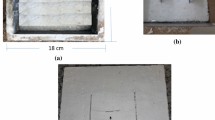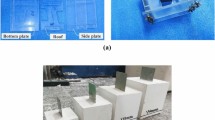Abstract
To investigate the size effects on the cracking behavior of flaw-containing specimens under compressive loading, rectangular parallelepiped specimens containing a single centrally located flaw are numerically loaded using the bonded-particle model (BPM). Effects of the ratio of flaw size (length) to specimen size on cracking behavior are carefully studied. The numerical results show that increasing the ratio of flaw size to specimen size within a reasonable range (≤0.33) has no obvious effects on the first crack initiation stress, but decreases the uniaxial compressive strength. In specimens of a high flaw size to specimen size ratio, the newly generated cracks have longer extension length, which allows for easier crack identification as compared with that of the low ratio specimens. These phenomena are also observed in the physical test. Based on the present study, recommendations are given on choosing appropriate specimen widths in the BPM simulation. The failures of flaw-containing specimens as well as the outward bending effect of narrow specimens are also discussed.







Similar content being viewed by others
References
Al-Busaidi A, Hazzard JF, Young RP (2005) Distinct element modeling of hydraulically fractured Lac du Bonnet granite. J Geophys Res Solid Earth 110:B06302. doi:10.1029/2004JB003297
Asadi MS, Rasouli V (2011) PFC2D simulation of directionality in rough fractures shear strength. In: 2nd international FLAC/DEM Symposium, Ist edn. Itasca Consulting Group, Melbourne
Ashby MF, Hallam SD (1986) The failure of brittle solids containing small cracks under compressive stress states. Acta Metall 34(3):497–510
Bieniawski ZT (1967) Mechanism of brittle fracture of rock: Part II—experimental studies. Int J Rock Mechan Min Sci Geomechan Abst 4(4):407–423
Bobet A (1997) Fracture coalescence in rock materials: experimental observations and numerical predictions, Ph.D. Thesis, Massachusetts Institute of Technology, Cambridge
Bobet A, Einstein HH (1998) Fracture coalescence in rock-type materials under uniaxial and biaxial compression. Int J Rock Mech Min Sci 35(7):863–888
Bombolakis EG (1963) Photoelastic stress analysis of crack propagation within a compressive stress field. Ph.D. Thesis, Cambridge, p 38
Brace WF, Bombolakis EG (1963) A note on brittle crack growth in compression. J Geophys Res 68(12):3709–3713
Chaker C, Barquins M (1996) Sliding effect on branch crack. Phys Chem Earth 21:319–323
Chen G, Kemeny JM, Harpalani S (1995) Fracture propagation and coalescence in marble plates with pre-cut notches under compression. Symposium fractured jointed rock masses, LakeTahoe
Cho N, Martin CD, Sego DC (2007) A clumped particle model for rock. Int J Rock Mech Min Sci 44(7):997–1010
Cundall PA (1971) A computer model for simulating progressive large scale movements in blocky rock systems. Proceedings of the Symposium of the International Society of Rock Mechanics, Nancy
Cundall PA, Strack OD (1979) A discrete numerical model for granular assemblies. Geotechnique 29(1):47–65
Fakhimi A (2004) Application of slightly overlapped circular particles assembly in numerical simulation of rocks with high friction angles. Eng Geol 74(1–2):129–138
Fakhimi A, Gharahbagh EA (2011) Discrete element analysis of the effect of pore size and pore distribution on the mechanical behavior of rock. Int J Rock Mech Min Sci 48(1):77–85
Fakhimi A, Villegas T (2007) Application of dimensional analysis in calibration of a discrete element model for rock deformation and fracture. Rock Mech Rock Eng 40(2):193–211
Hazzard JF, Young RP, Maxwell SC (2000) Micromechanical modeling of cracking and failure in brittle rocks. J Geophys Res Solid Earth 105(B7):16683–16697
Hoek E, Bieniawski ZT (1965) Brittle fracture propagation in rock under compression. Int J FractMech 1(3):137–155
Horii H, Nematnasser S (1985) Compression-induced microcrack growth in brittle solids: axial splitting and shear failure. J Geophys Res Solid Earth Planets 90(NB4):3105–3125
Huang JF, Chen GG, Zhao YH, Wang R (1990) An experimental study of the strain field development prior to failure of a marble plate under compression. Tectonophysics 175(1–3):269–284
Ingraffea AR, Heuze FE (1980) Finite-element models for rock fracture-mechanics. Int J Num Anal Meth Geomech 4(1):25–43
Ko TY (2005) Crack coalescence in rock-like material under cyclic loading, MSc. thesis, Massachusetts Institute of Technology, Cambridge, p 184
Ko TY, Einstein HH, Kemeny J (2006) Crack coalescence in brittle material under cyclic loading. In: Proceeidngs of the 41st U.S. Symposium on Rock Mechanics (USRMS): “50 Years of Rock Mechanics—Landmarks and Future Challenges.” Golden, Colorado
Lajtai EZ (1971) A theoretical and experimental evaluation of the Griffith theory of brittle fracture. Tectonophysics 11:129–156
Lee H, Jeon S (2011) An experimental and numerical study of fracture coalescence in pre-cracked specimens under uniaxial compression. Int J Solids Struct 48(6):979–999
Li YP, Chen LZ, Wang YH (2005) Experimental research on pre-cracked marble under compression. Int J Solids Struct 42(9–10):2505–2516
Liu SG, Liu HN, Wang SJ, Hu B, Zhang XP (2008) Direct shear tests and PFC2D numerical simulation of intermittent joints. Yanshilixue Yu Gongcheng Xuebao/Chin J Rock Mechan Eng 27(9):1828–1836
Martinez AR (1999) Fracture coalescence in natural rock, MSc. thesis, Massachusetts Institute of Technology, Cambridge, p 341
Morgan SP, Johnson CA, Einstein HH (2013) Cracking processes in Barre granite: fracture process zones and crack coalescence. Int J Fract 180(2):177–204
Mughieda O, Alzo’ubi AK (2004) Fracture mechanisms of offset rock joints—a laboratory investigation. Geotech Geol Eng 22(4):545–562
Nematnasser S, Horii H (1982) Compression-induced nonplanar crack extension with application to splitting, exfoliation, and rockburst. J Geophys Res 87(NB8):6805–6821
Nesetova V, Lajtai EZ (1973) Fracture from compressive stress concentrations around elastic flaws. Int J Rock Mech Min Sci 10(4):265–284
Ning YJ, An XM, Ma GW (2011) Footwall slope stability analysis with the numerical manifold method. Int J Rock Mech Min Sci 48(6):964–975
Park CH, Bobet A (2009) Crack coalescence in specimens with open and closed flaws: a comparison. Int J Rock Mech Min Sci 46(5):819–829
Park CH, Bobet A (2010) Crack initiation, propagation and coalescence from frictional flaws in uniaxial compression. Eng Fract Mech 77(14):2727–2748
Park JW, Song JJ (2009) Numerical simulation of a direct shear test on a rock joint using a bonded-particle model. Int J Rock Mech Min Sci 46(8):1315–1328
Petit JP, Barquins M (1988) Can natural faults propagate under model II conditions? Tectonics 7(6):1243–1256
Potyondy DO (2007) Simulating stress corrosion with a bonded-particle model for rock. Int J Rock Mech Min Sci 44(5):677–691
Potyondy DO, Cundall PA (2004) A bonded-particle model for rock. Int J Rock Mech Min Sci 41(8):1329–1364
Reyes O, Einstein HH (1991) Failure mechanism of fractured rock-a fracture coalescence model. Proceedings of the seventh international congress on rock mechanics, Aachen, pp 333–340
Sagong M, Bobet A (2002) Coalescence of multiple flaws in a rock-model material in uniaxial compression. Int J Rock Mech Min Sci 39(2):229–241
Sarmadivaleh M, Rasouli V (2010) Studying the controlling parameters in Hydraulic Fracturing and fracture containment in tight formations. APPEA J 50:581–591
Sarmadivaleh M, Rasouli V, Nabipour A (2011) A PFC2D simulation of hydraulic fracture and natural interface interaction. In: 2nd international FLAC/DEM symposium, Ist edn. Itasca Consulting Group, Melbourne
Shen BT, Stephansson O, Einstein HH, Ghahreman B (1995) Coalescence of fractures under shear stresses in experiments. J Geophys Res Solid Earth 100(B4):5975–5990
Wong NY (2008) Crack coalescence in molded gypsum and Carrara Marble, PHD thesis, Massachusetts Institute of Technology, Cambridge, p 876
Wong RHC, Chau KT (1997) The coalescence of frictional cracks and the the shear zone formation in brittle solids under compressive stresses. International Journal of Rock Mechanics and Mining Sciences 34(3–4):335.e1–335.e12
Wong RHC, Chau KT (1998) Crack coalescence in a rock-like material containing two cracks. Int J Rock Mech Min Sci 35(2):147–164
Wong LNY, Einstein HH (2009a) Crack coalescence in molded gypsum and carrara marble: part 1. Macroscopic observations and interpretation. Rock Mech Rock Eng 42(3):475–511
Wong LNY, Einstein HH (2009b) Crack coalescence in molded gypsum and Carrara marble: Part 2-microscopic Observations and Interpretation. Rock Mech Rock Eng 42(3):513–545
Wong LNY, Einstein HH (2009c) Using high speed video imaging in the study of cracking processes in rock. Geotech Test J 32(2):164–180
Wong LNY, Zhang X-P (available online) Size effects on cracking behavior of flaw-containing specimens under compressive loading. Rock Mech Rock Eng
Wong RHC, Chau KT, Tang CA, Lin P (2001) Analysis of crack coalescence in rock-like materials containing three flaws—Part I: experimental approach. Int J Rock Mech Min Sci 38(7):909–924
Wu Z, Wong LNY (2013) Elastic-plastic cracking analysis for brittle-ductile rocks using manifold method. Int J Fract 180(1):71–91
Xia M, Zhou KP (2010) Particle simulation of the failure process of brittle rock under triaxial compression. Int J Min Metal Mater 17(5):507–513
Yang SQ, Jing HW (2011) Strength failure and crack coalescence behavior of brittle sandstone samples containing a single fissure under uniaxial compression. Int J Fract 168(2):227–250
Zhang X-P, Wong LNY (2012) Cracking processes in rock-like material containing a single flaw under uniaxial compression: a numerical study based on parallel bonded-particle model approach. Rock Mech Rock Eng 45(5):711–737
Zhang X-P, Wong LNY (2013a) Crack initiation, propagation and coalescence in rock-like material containing two flaws—a numerical study based on bonded-particle model approach. Rock Mech Rock Eng 46(5):1001–1021
Zhang X-P, Wong LNY (2013b) Loading rate effects on cracking behavior of flaw-contained specimens under uniaxial compression. Int J Fract 180(1):93–110
Zhang X-P, Wong LNY (2014) Displacement field analysis for cracking processes in bonded-particle model. Bull Eng Geol Environ 73(1):13–21
Zhang Q, Zhu HH, Zhang LY, Ding XB (2011) Study of scale effect on intact rock strength using particle flow modeling. Int J Rock Mech Min Sci 48(8):1320–1328
Zhao CB, Hobbs BE, Ord A, Peng SL (2007) Particle simulation of spontaneous crack generation problems in large-scale quasi-static systems. Int J Num Meth Eng 69(11):2302–2329
Acknowledgments
This research was supported by the Academic Research Fund Tier 1 (RG19/10) and the Nanyang Technological University Start Up Grant (M4080115.030). The first author was also supported by the National Natural Science Foundation of China, under Contract/Grant No. 41302235. Many thanks are given to Ms Kangle Li for assisting the uniaxial compression tests, and Ms Vivian Wei Wen Teh, Mr Yi Cheng, Ms Eunice Shu Fen Tan and Ms WanLing Chong for preparing the gypsum specimens.
Author information
Authors and Affiliations
Corresponding author
Additional information
Xiao-Ping Zhang was formerly at the School of Civil and Environmental Engineering, Nanyang Technological University, Block N1, Nanyang Avenue, 639798, Singapore.
Rights and permissions
About this article
Cite this article
Zhang, XP., Wong, L.N.Y. & Wang, S. Effects of the ratio of flaw size to specimen size on cracking behavior. Bull Eng Geol Environ 74, 181–193 (2015). https://doi.org/10.1007/s10064-014-0596-6
Received:
Accepted:
Published:
Issue Date:
DOI: https://doi.org/10.1007/s10064-014-0596-6




